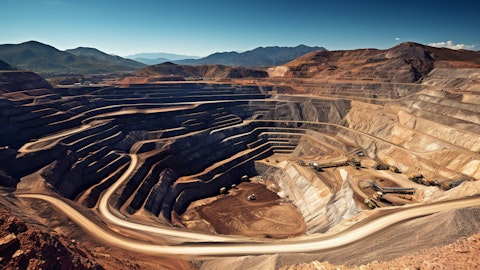Cosan S.A. (NYSE:CSAN) Q2 2025 Earnings Call Transcript August 15, 2025
Operator: Good morning, everyone, and thank you for waiting. Welcome to Cosan’s Second Quarter 2025 Earnings Release Conference Call. [Operator Instructions]. The conference call is being recorded and will be available on the company’s IR website at cosan.com.br. [Operator Instructions] Please note that the information contained in this presentation and in statements that may be made during the conference call regarding Cosan’s business prospects, projections and operating and financial goals constitute the beliefs and assumptions of the company’s management as well as information currently available. Forward-looking considerations are not a guarantee of performance. They involve risks, uncertainties and assumptions as they refer to future events and, therefore, depend on circumstances that may or may not materialize.
Investors should bear in mind that overall economic circumstances, market conditions and other operating factors may affect Cosan’s future performance and lead to results that differ materially from those expressed in such forward-looking statements. I will now turn it over to Mr. Rodrigo Araujo.
Rodrigo Araujo Alves: Hello, everyone. Welcome to our earnings call for the second quarter of 2025. We start with our usual disclaimers about future projections and future operations of the company. So starting with the highlights of the second quarter of 2025, we start with our EBITDA under management of roughly BRL 6 billion this quarter. slightly below last year, and we’re going to talk a little bit about the details of each one of the portfolio companies following during the call. We had a negative net income of about BRL 1 billion in the quarter. We also had our net debt stable when we compare to the first quarter of 2025. Our debt service coverage ratio is also stable compared to the quarter, mostly coming from dividends that we received from Rumo and Radar that accounted for roughly BRL 600 million in this quarter.

And also in terms of our safety metric, we also had an important improvement in this quarter when compared to the first quarter. We unfortunately had a fatality in the quarter, but we continue to have safety as a strong value of the company and continue to disclose important operational and safety results throughout the portfolio. So talking about the operating performance of the different businesses. In Rumo, we had higher transported volumes, basically translated into a higher EBITDA. We also had an increase in terms of market share in the Port of Santos. That was the result of a change in the tariff dynamics. So we had lower tariffs compared to last year, but that translated also into higher volumes transported. In Compass, we continued to see the growth of the portfolio and mostly we had an important impact, not only in volumes, but also in terms of the mix.
So we had higher sales in the residential segment that also brings higher margins. We also had an important increase in the volume traded by Edge. So we continued to ramp up the terminal in the Port of Santos and to ramp up the strategy of being a relevant player in the unregulated gas market in Brazil. The lower EBITDA compared to last year is mostly because of nonrecurring events that happened on 2024. So basically, on a recurring basis, we had better results. In Moove, we had the reduction in the volumes sold, mostly given the fire that happened in February this year. We continue our recovery trajectory. And in this quarter, we also started accounting for the impacts of the insurance related to the event that happened in February this year.
In Radar, we had the sale of a farm in the second quarter of ’25, and we had stable EBITDA compared to ’24. So we continue as we’ve been mentioning to divest partially from the land in the portfolio, and we also continue to have a relevant BRL 17 billion portfolio, even though some divestitures have been going on. And in Raizen, we had a positive result in the fuel distribution segment, with better margins, healthier margins and higher volumes as well. But we had the negative impact of the delay in the sugarcane crushing given the weather and the fire that happened in the previous harvest. So those impacted negatively the EBITDA of Raizen this quarter. In terms of liability management, there was no relevant event in this quarter. We, as I mentioned, have the gross and the net debt stable compared to last quarter.
Our debt service coverage ratio is also stable compared to last quarter. And we have a slight decrease in the average cost of our debt, from — CDI plus 90 bps to CDI plus 88, and an average duration of 6.2 years. Finally, in terms of our cash movements for the quarter, as I’ve mentioned, we had dividends paid from Radar and from Rumo this quarter, that was the most relevant event in the quarter. We had the interest payments also consuming part of the cash in this quarter. So those were the main highlights for the second quarter of 2025. And thank you for joining us today in our earnings call. And please let’s move on to the Q&A session. Thank you.
Q&A Session
Follow Cosan S.a. (NYSE:CSAN)
Follow Cosan S.a. (NYSE:CSAN)
Receive real-time insider trading and news alerts
Operator: We will now begin the Q&A session with Mr. Marcelo Martins, Mr. Rodrigo Araujo and Mr. Fernando Tinal. [Operator Instructions] Our first question is from Matheus Enfeldt from UBS.
Matheus Enfeldt: [Interpreted] My first question is about Moove. I’d like to understand the results in this quarter, especially when it comes to the insurance. What was the impact on the profit you didn’t get in terms of the EBITDA? And what about the insurance of the asset itself? Just so I can understand the results. And thinking ahead, what kind of insurance recurrence will we have on those profits that you didn’t make? And how will you be negotiating with the insurance company? So if you could update us on that topic, that would be great. And my second question is about the debt service coverage ratio and how it’s moving forward. It sounds to me like your payment on net interest was quite low in this quarter. Maybe that’s going to affect the cash over the next quarter, so that will put pressure on the debt service coverage ratio.
So doing the math, considering a net debt average of BRL 21 billion with an average interest rate of 13% to 14%, so the net cash interest should be BRL 2.9 billion, and it was closer to BRL 2.3 billion. So could you tell us more about the dynamics? Are we doing the math right? Or has there really been a cash interest concentration until the half of the year?
Unidentified Company Representative: [Interpreted] Thanks, Matheus. Good morning. Thanks for the question. I’ll start by giving you an update on Moove. First, it’s important to highlight that the company is still completely focused on its recovery and making sure that the regulation process takes place properly for all stakeholders based on the insurance regulations. And in this quarter, you saw just over BRL 400 million. That’s a result of the progress in the regulation process. It’s important to say that, as you said, the size of the impact will be seen over time, obviously, over the next few quarters. We will continue without any guidance. But it’s important to point out that production is resuming month after month with a whole new manufacturing system involving Rio de Janeiro but also Sao Paulo as part of the manufacturing ecosystem.
Capacity is no longer an issue for the company. It’s important to point that out. And obviously, given what happened, the company is reacting to the fire, working on fiscal efficiency and logistics to operate with a different type of organization to the original. But this quarter, there’s been a considerable pickup on market share, for instance. And looking forward, obviously, it includes a better and more modern plant in Rio, which will leverage competitiveness, profitability and so much so that we are already seeing CapEx and the reconstruction of the plant in Rio will happen. It’s relevant and it’s already taking place. Obviously, in the future, the company will operate in a different manufacturing organization. So it won’t be completely focused in Rio de Janeiro.
So the Rio de Janeiro plant won’t be the same as it was. But that’s roughly the scenario. And as I said, the size of the impact concerning the insurance will be seen in the following quarters. As to your second question on the debt service coverage ratio, a couple of things. Your way of looking at it is right, but you need to separate things. Part of our debt, which we have shared with you, as a bullet, so there’s no payment of intermediate interest, and there’s also the dynamics of the bonds and debentures following the coupon schedule. So it’s right in the sense that some things are in the accrual, but were not cash in the quarter. And that’s business as usual, it’s no different to previous quarters. You are right in the sense that there should be a reduction in the debt service coverage ratio in the future, so much so that we are working on reducing leverage in a structural fashion across the company.
Operator: The next question is from Thiago Duarte from BTG Pactual.
Thiago Callegari L. Duarte: [Interpreted] I want to go back to Moove briefly, please. I want to talk about the volume dynamics. Volumes were similar to the previous quarter where, when the fire took place, in theory, it didn’t affect the whole quarter. So it feels like the volume recovery in the second quarter happened quite rapidly. You mentioned that briefly in your earnings report, but I’d like to hear more about the recovery to be able to meet capacity and volumes. And if possible, what kind of pace did those volumes came in at the end of the quarter to understand how they will be moving forward? Now the second question is about the priority of recycling your portfolio and the divestitures and reducing the group’s debt. Could you give us an update on — I mean, in the last few earnings release calls, both you, Rodrigo and Marcelo, talked a lot about options and the many leverages that the company has post the Vale divestiture to continue to reduce your indebtedness.
You talk a lot about priorities. So some assets you want to wait until they’re a bit more mature. You see other assets as key to your portfolio. So you have different ways to generate cash, resilience, stability, more commodities. So we’re halfway through August now and I’d like to hear from you if any of those priorities have changed given that time is not on your side given the cost of debt, high interest rates, or if what you said as the assets that are more monetizable still makes sense. So that’s my second question.
Rodrigo Araujo Alves: [Interpreted] I’ll start by Moove. I think it’s important to highlight that even though there was a fire in the first quarter, the company did have the inventory to manage things over a bit of time. Now in terms of the volume dynamics, it’s key to point out that the company’s strategy focused entirely on preserving our distributors network, our key clients and to make sure that we kept the volumes because the customer base is what ensures the company’s future competitiveness, even if, at the time, we need to use a new manufacturing ecosystem with some inefficiencies. What we’re focusing on is preserving the company’s customer base to make sure that the ramp-up happens over time. Now something I mentioned when I was answering Matheus, every month, we see a positive dynamic.
Every month, not only the company is recovering volumes, but we’re understanding the dynamics and understanding better how to deal with those inefficiencies, how to keep its customer base and to keep it as profitable as possible. So much so that this quarter, there is market data on that, the company is going back to a considerable market share compared to what happened right after the fire. So there’s been considerable market share recovery in the period. As to your second question, I’ll start and then I’ll turn it over to Marcelo. About priorities and options, something that has absolutely not changed, and we are aware of time and the fact that it might not be on our side, our perspective hasn’t changed. We will make sure that the end of this journey involves a high-quality portfolio that is equal or better than the original.
So that is a significant variable. We will not affect the quality of the portfolio just to focus on the speed with which we’re going to deleverage. Marcelo?
Marcelo Eduardo Martins: [Interpreted] Adding to what Rodrigo said, first of all, deleveraging is a major priority for the company. Second, deleveraging is a challenge for us whilst keeping a well-balanced portfolio. And third, we do have assets that we would consider partially selling right now. In terms of selling those assets, there are some ongoing discussions. They have been ongoing for a while. Some of them are more recent. And by the end of the year, we want to have a clear indication from the market in terms of what the businesses we will be monetizing will be so that we can raise the funds we believe to be adequate for now. Now Cosan’s deleveraging efforts will not come to an end this year, as we’ve said before. Our objective is to get to debt that is close to 0 at the holdco level at Cosan.
Because it doesn’t make sense for us to carry on with this debt at the holdco where we have fiscal inefficiencies. But that’s no news. We’ve talked about that before. Now a well-balanced portfolio is a key point at a time when we are discussing options for Raizen. So that is a solution that is part of our strategy right now. I have mentioned this before and I will repeat it before I’m asked again. Right now, it does not make sense to Cosan to put more capital into Raizen because it is looking into finding a balance in its own capital structure. So we’re not going to invest in a capital in Raizen. We do understand Raizen’s portfolio’s challenges. We are addressing those assets with Shell, and we’ll move forward doing that. And we hope to have something to the market as soon as possible.
But what I want to make clear is that not only there is a sense of urgency to find alternatives, but we are on track and we have even more alternatives now than we had a few months ago. Now executing on those transactions is not something obvious, especially given the current time Brazil is going through with the volatility that we’re all seeing. But we are completely focused on finding a way out for Cosan’s capital structure and looking at the other companies in the portfolio.
Operator: The next question is from Monique Grego from Itau BBA.
Monique Martins Greco Natal: [Interpreted] Marcelo, since you touched on Raizen and the fact that you are addressing the challenges, yesterday, we attended Raizen’s earnings release call and the talk with investors and discussing the possibilities of a strategic partner as an option. So my first question is, could you share with us what are the ideal conditions to maybe bringing in a strategic partner? And how does that fit in with your other options? And let me follow up on one of the questions. I don’t want to be repetitive. But if you could give us a bit more color on when do you expect to receive the insurance claims and what kind of cash can we expect to see coming in from the insurance? And also, what is the current potential to generate results in Moove considering this new production arrangements, as Rodrigo said? You will be rebuilding the plant, but it will be different. So what can we expect in terms of potential current results generation at Moove?
Rodrigo Araujo Alves: [Interpreted] Monique, thank you for your question about Raizen. I’ll start and then I’ll turn it over to Marcelo. Before we talk about any partners, I think it’s important to reiterate a couple of messages that were shared yesterday during the earnings release call. But as a shareholder, we should say that the company is doing an incredible job. They’re doing a fantastic job. In the second quarter, in fuel distribution, we did better than the competition. There have been market share gains and a G&A reduction. They are optimizing the team, the portfolio, their structure. They’re also going through an asset sale process that is much better than we had anticipated, and delivering on that. So in terms of what the company management can do, we are extremely happy with the results we’ve been seeing.
Now as for bringing in a partner, considering Cosan’s leverage ratio, we are focusing on attracting a new strategic partner to the business. Given Cosan’s capital structure restrictions, that would be diluted in an eventual capitalization. But I’ll turn it over to Marcelo so he can add to what I just said.
Marcelo Eduardo Martins: [Interpreted] Well, the fact is that bringing in a strategic partner is an option we do like. The first capital contribution is key in bringing in somebody who is in line with our and Shell’s strategy is also important to the business. That is an effort we are pursuing jointly with Shell. Obviously, it’s too soon to say how things will pan out, but we have confirmed through a company announcement that there is a joint effort towards doing that, towards executing on the plan, knowing that the company does need capital and understanding that it might be possible to bring in a partner that will have the same focus on strategy, that would be a priority for us and Shell as well. And we know that there are some options that might make sense.
So as we move forward, we will be updating you. Again, there is a sense of urgency. Timing is key to us, both for Cosan and Raizen. And we are trying to speed things up as much as possible. But as we said yesterday, I will reiterate the fact that we are interested in pursuing, bringing a strategic partner in for Raizen. As to your second question about Moove, we won’t be disclosing any guidance in terms of what will happen to the company. But let me just reiterate a couple of points. First, if regulation goes as planned and the process with stakeholders as well, that will be key. And the second point is the company is working on and will continue to work on the optimization of this new ecosystem. As I mentioned, in terms of volume, we are on track.
It is key to highlight that. Now we are focusing — so if we have ensured the customers and the volume, how can we optimize our operation? That’s where we are. And every month, we are looking for improvements and opportunities for improvement.
Operator: The next question is from Gabriel Barra, Citi.
Gabriel Coelho Barra: [Interpreted] My question is on the same topic, but slightly different. I remember your Investor Day a few years ago talking about the partnership and succession. And now, looking at the current situation in terms of the balance sheet and your will to deleverage and what’s happening to Raizen, the need for capital and the current scenario in terms of priorities and the fact that capital allocation is not a priority, how about a capitalization at Cosan? Thinking of succession or long-term partnership, not for now, but considering the Raizen scenario, wouldn’t it make sense to bring in a partner and to increase capital at Raizen but through a capital increase at Cosan? Couldn’t that be a possibility if you don’t get this third player coming into Raizen?
Unidentified Company Representative: [Interpreted] Gabriel, I’ll start by the second one. I want to make it very clear that there are 2 very different things. So not bringing in a third player into Raizen has nothing to do with increasing capital at Cosan. Even if it’s key to deal with Raizen’s capital structure issue, that is a priority for us, but that doesn’t mean anything has to happen at Cosan. Now in terms of succession at Cosan, we know that, that is a key topic. To me, that is a top priority, right along the capital structure issue, and we will have to address it in time. Generally speaking, the management of the company is aware of the importance of that. We discussed it. And it’s something it has to be decided on by Rubens and his family.
We have discussed it with him. Now in terms of executing on the plan, our priority is assets — that we will be monetizing on some assets partially. We’re not going to sell any company in the portfolio in its entirety. I want to make that clear. We want to have access to a resource pool that will help us with the strategy to rebalance our capital structure as a first step. Now increasing capital is something that has to be discussed with Rubens. And if it happens, it will happen at the right time and with the objective of also looking at succession, I do agree with you. But it has to happen at the right time after it’s discussed and agreed on with Rubens and after we have addressed the more relevant capital structure issues at Cosan. So we’ll start with the assets.
We’ll follow the sequence of events. We’ll look at Raizen, discuss the options with Rubens in terms of the future and succession with him and the family. And we might get to the point you mentioned. But that’s not something I can discuss with you at the moment.
Operator: The next question is from Gustavo Sadka, Bradesco BBI.
Gustavo Sadka: [Interpreted] I have one question, because I think most of the questions have already been asked. About the dividends, it’s a moot point that Raizen — paying out dividends is a bottom priority for Raizen at the moment. But Compass had some excellent results, strong cash generation, leverage under control. Would it be fair to think that Compass might pay out dividends above its 50% payout policy in the short term? And as for Moove, considering all the restructuring, Moove was — also paid out some good dividends in the recent past. So given the recent restructuring and the insurance money coming in, would it be fair to think or to expect that, not this year, but maybe 2026 or ’27, that Moove might become a major dividend payer for the holding company?
Unidentified Company Representative: [Interpreted] We’re not disclosing any dividend guidance for the business. It’s much more about exercise understanding what’s happening right now. And you’re right. I’m not, as I said, disclosing any value guidance. But Compass is a company that has a stable and growing business. It’s resilient to the cycle and it is generating cash. So naturally, it tends to be a company that will pay out good dividends, and that’s what we expect moving forward. But I won’t be disclosing any guidances. It’s too soon to talk about Moove. Right now we are focusing much more on making sure that the company is back on track compared to where we were. There has been considerable progress and we’re very happy with what we’re seeing.
But it’s too soon to talk about it. Now looking forward, obviously, it always has and will continue to generate cash. It’s a healthy company. It’s just going through a rough patch. So looking to the mid to the long run, you’re right, the company will generate a lot of cash. It’s financially healthy. But right now, the focus is much more on bringing the company back on track to its full operating capacity and addressing the insurance regulation process.
Operator: The next question is from [ Rohm Rodrigues ] from XP.
Unidentified Analyst: [Interpreted] Some of my questions have already been answered. I have a follow-up question about Moove. The asset that was accounted for, BRL 491 million in the loss/profit, is that a preliminary assessment? Have you made any progress on whether you might be receiving that? Is there any more red tape that you need to go through with the insurance company to make sure that that is the right amount? And do you know roughly when you’ll be able to monetize on that asset?
Unidentified Company Representative: [Interpreted] In practice, the amount we accounted for, we couldn’t disclose that. We couldn’t disclose which insurance categories. We have talked about that in previous earnings release calls. The company didn’t just have the loss/profit. There’s also the environmental side. There’s also the fact that we are rebuilding the plant already. So that’s the full amount. Now in terms of estimates for the future, we won’t be disclosing our guidance on that. As I said, we will be realizing the size of the impact in the future and we will account for additional items in the future. Now in terms of how long it will take to monetize that, the regulation process is ongoing, and obviously, it involves many different stakeholders. And we have no estimate in terms of the timing for the monetization. The only thing I can say is that the regulation process is on track, and we’re all happy with how it’s going.
Operator: This concludes Cosan second quarter 2025 earnings release video conference. For further questions, please contact the Investor Relations department. Thank you so much for joining us, and have a great afternoon. [Portions of this transcript that are marked [Interpreted] were spoken by an interpreter present on the live call.]
Follow Cosan S.a. (NYSE:CSAN)
Follow Cosan S.a. (NYSE:CSAN)
Receive real-time insider trading and news alerts





